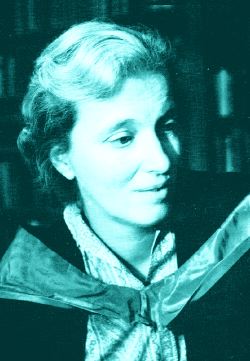

 Dorothy Mary Crowfoot was born in Cairo, Egypt, on May 12, 1910. She attended Somerville College at Oxford in 1932 and received a Chemistry degree. While in college, Dorothy used x-ray crystallography to show atomic structure and discovered that crystals are made of atoms in repeating, regular patterns.
Dorothy Mary Crowfoot was born in Cairo, Egypt, on May 12, 1910. She attended Somerville College at Oxford in 1932 and received a Chemistry degree. While in college, Dorothy used x-ray crystallography to show atomic structure and discovered that crystals are made of atoms in repeating, regular patterns.
 In 1933, Dorothy began her real crystallography research. She determined the structural atom layout and certain molecules' molecular shape. She also recorded the first x-ray diffraction pattern of a globular protein with Dr. J. D. Bernal. This determined that a protein molecule's arrangement is perfectly definite and that mother liquid is needed to surround protein crystals in order to study them. Also with her research, she showed crystal packing molecules and their scheme of hydrogen bonds. This was a great chemical breakthrough because they were the first analyses made from 3-D calculations.
In 1933, Dorothy began her real crystallography research. She determined the structural atom layout and certain molecules' molecular shape. She also recorded the first x-ray diffraction pattern of a globular protein with Dr. J. D. Bernal. This determined that a protein molecule's arrangement is perfectly definite and that mother liquid is needed to surround protein crystals in order to study them. Also with her research, she showed crystal packing molecules and their scheme of hydrogen bonds. This was a great chemical breakthrough because they were the first analyses made from 3-D calculations.
 In 1934, Dorothy returned to Oxford University and took x-ray photographs of insulin by herself, changing modern biolgoy. Then, in 1937, she graduated from Cambridge University with a doctorate and married Dr. Thomas Hodgkin.
In 1934, Dorothy returned to Oxford University and took x-ray photographs of insulin by herself, changing modern biolgoy. Then, in 1937, she graduated from Cambridge University with a doctorate and married Dr. Thomas Hodgkin.
 Between 1942 and 1949, Dorothy worked to identify penicillin's structure, which she established in 1945 with x-ray crystallography, and then made further clarifications. In 1947, she became a member of Britain's scientific organization, the Royal Society.
Between 1942 and 1949, Dorothy worked to identify penicillin's structure, which she established in 1945 with x-ray crystallography, and then made further clarifications. In 1947, she became a member of Britain's scientific organization, the Royal Society.
 From 1948 to 1956, Dorothy served as a tutor at Cambridge University and Oxford University. In 1955, she took the first x-ray diffraction pictures of Vitamin B-12. In 1956 and 1958, she received the Royal Medal and became a member of the American Academy of Arts and Sciences, respectively.
From 1948 to 1956, Dorothy served as a tutor at Cambridge University and Oxford University. In 1955, she took the first x-ray diffraction pictures of Vitamin B-12. In 1956 and 1958, she received the Royal Medal and became a member of the American Academy of Arts and Sciences, respectively.
 In 1961, Dorothy determined the structure of the naturally-occurring Vitamin B-12, and since Vitamin B-12 helps build red blood cells, it became a treatment for anemia. From 1960 to 1977, Dorothy was at Oxford University as the Royal Society Wolfson Research Professor. In 1964, she won the Nobel Prize in Chemistry for her structure of Vitamin B-12. In 1965, she became a member of the Order of Merit, endowed by Queen Elizabeth II. Then, finally, in 1969, she completed insulin's structure and it became helpful in treating diabetes.
In 1961, Dorothy determined the structure of the naturally-occurring Vitamin B-12, and since Vitamin B-12 helps build red blood cells, it became a treatment for anemia. From 1960 to 1977, Dorothy was at Oxford University as the Royal Society Wolfson Research Professor. In 1964, she won the Nobel Prize in Chemistry for her structure of Vitamin B-12. In 1965, she became a member of the Order of Merit, endowed by Queen Elizabeth II. Then, finally, in 1969, she completed insulin's structure and it became helpful in treating diabetes.
 In 1970, Dorothy was Britol University's Chancellor and from 1972 to 1978, she was President of the International Union of Crystallography. She received the Copley Medal (1976), retired in 1977, and received the Longstaff Medal, Lamonosov Gold Medal, and Lenin Peace Prize in 1978, 1982, and 1987, respectively.
In 1970, Dorothy was Britol University's Chancellor and from 1972 to 1978, she was President of the International Union of Crystallography. She received the Copley Medal (1976), retired in 1977, and received the Longstaff Medal, Lamonosov Gold Medal, and Lenin Peace Prize in 1978, 1982, and 1987, respectively.
 Dorothy died from a stroke in Ilmington, England, on July 29, 1994. She had done much to contribute to the field of chemistry, but she had also adopted over 75 children in need of homes from many different countries around the world.
Dorothy died from a stroke in Ilmington, England, on July 29, 1994. She had done much to contribute to the field of chemistry, but she had also adopted over 75 children in need of homes from many different countries around the world.
